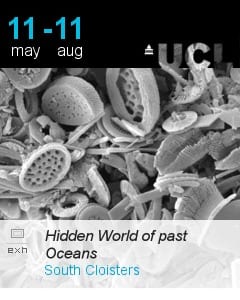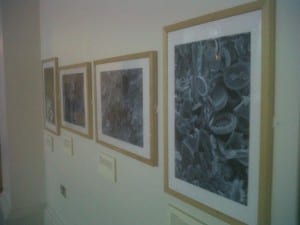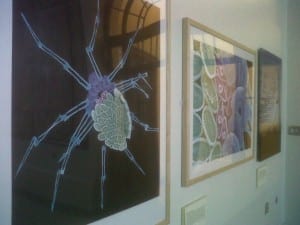The Hidden World of Past Oceans
By zcqsd60, on 27 July 2011
Hidden World of Past Oceans is an exhibition of the wonderful “architecture, beauty and diversity” of microfossils that UCL researchers are using to study Earth’s previous oceans.
Professor Paul Bown, Drs Jackie Lees and Stuart Robinson (UCL Earth Sciences) have been taking part in the Tanzania Drilling Project by examining these microfossils in collaboration with an international research team.

The exhibition consists of 27 images with captions and two info boards (duplicates of each other, one at either end) and takes you on a journey of scientific discovery through the investigation process to the unknown questions still being considered.
In some places, it was difficult to see the images completely due to reflections from the opposite windows, but the captions were well-written and explained the images and necessary ‘jargon’ clearly.
 The specific levels of sediments that the team were looking at covered two particularly warm, ‘supergreenhouse’ periods in the global climate, 93 and 56 million years ago. Their research is revolutionising the way that palaeoclimate change through greenhouse intervals is being thought about: the changes in the abundance of species that they are measuring gives important information about the environment in the upper part of the ocean.
The specific levels of sediments that the team were looking at covered two particularly warm, ‘supergreenhouse’ periods in the global climate, 93 and 56 million years ago. Their research is revolutionising the way that palaeoclimate change through greenhouse intervals is being thought about: the changes in the abundance of species that they are measuring gives important information about the environment in the upper part of the ocean.
The exhibition itself starts by giving context to the science with images of the community in Tanzania, describing the cataloguing process and explaining that any water uncovered during the drilling process is used by the community after the scientists leave.
The images then move on to specific types of microfossils; forams, nannoplankton and montages of both (see image above). As a physicist I automatically assumed that ‘nannoplankton’ was a misspelling of ‘nanoplankton’, until I realised they are not on the scale of 10-9 m (10-9 m = 1 nanometre). Apparently both ‘nanno’ and ‘nano’ come from the Greek root ‘nanos’ meaning ‘dwarf’ or ‘little man’, but ‘nano’ now has those standard unit implications whereas ‘nanno’ just means very small. (Edit: To clarify, the spelling of ‘nannoplankton’ was standardised long before ‘nano’ became part of SI units – thanks to Dr Jeremy Young)
 The next four images are two sets of two. The first of each is an individual example of a specific microfossil and the second is a more ‘zoomed out’ view of that microfossil alongside many others. The first of these looks a little like a dessert in my opinion!
The next four images are two sets of two. The first of each is an individual example of a specific microfossil and the second is a more ‘zoomed out’ view of that microfossil alongside many others. The first of these looks a little like a dessert in my opinion!
The exhibition then moves on to look at how these microfossils are connected with the modern day Earth; for example, by comparing them with living examples of the same species and explaining that coccolithophores (a specific type of nannoplankton) act as the grass or rainforests of the ocean by removing CO2 and using sunlight to convert it to food.
 In the right nutrient and temperature levels, these organisms can produce a fantastic “bloom” event, which lasts only a few days. Each coccolithophore itself is very small (see left of image above), but together they can change the apparent colour of spectacularly large areas of ocean (see right of image above).
In the right nutrient and temperature levels, these organisms can produce a fantastic “bloom” event, which lasts only a few days. Each coccolithophore itself is very small (see left of image above), but together they can change the apparent colour of spectacularly large areas of ocean (see right of image above).
The final two images of the exhibition represent two important results of research such as this: the explanation of familiar sights, such as the famous White Cliffs of Dover, and ongoing scientific speculation about unexplained features, such as the primary evolutionary reason for the shells of coccolithophores.
This was a great exhibition and taught me a lot about the importance of studying microfossils, as well as the role of UCL scientists in that research, so I strongly recommend going before it closes on 11 August.
One Response to “The Hidden World of Past Oceans”
- 1
 Close
Close


Glad you enjoyed the exhibition and thanks for the write up. On the nano- nanno- issue the spelling of nannoplankton was fixed in 1902 long before SI made nano- the “standard” spelling.